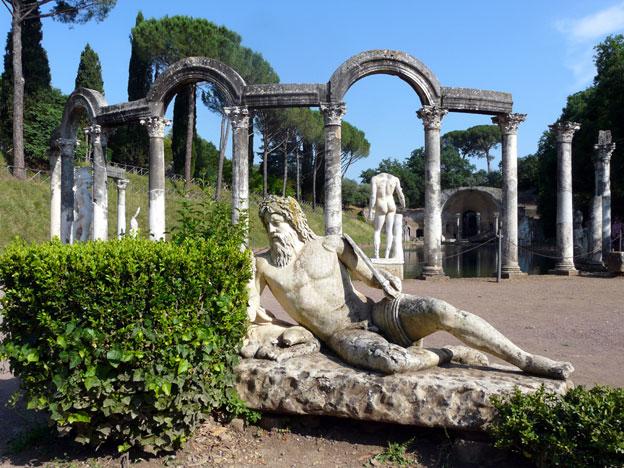(In the photo: Hadrian's Villa in Tivoli)
In our ongoing series about the Ancient Romans, where we commemorate the 2,000th anniversary of the death of Rome's first emperor, Augustus, celebrated in 2014, Carol King learns what home sweet home signified for the Ancient Romans.
You can read part one of the series, "The Romans: What They Ate" here; part two, "The Romans: Marriage and Weddings" here; part three, "The Romans: Top 5 Emperors" here; part four, "The Romans: What they Wore" here; part 5, "The Romans: Gladiators" here.
What is perhaps most surprising about Roman housing is that it appears so similar in style to that of today. The plebeians (lower classes) and middle classes lived in insulae or apartment blocks, the middle and upper classes in domus townhouses, and the well-heeled and powerful in villas.
Insulae were built of wood, mud bricks or concrete. The multi-storey buildings had anything from three to nine floors, often designed around an open courtyard or light well. They usually had running water and lavatories. However, the uppermost floors would have the smallest apartments that sometimes lacked sanitation and so were the cheapest to rent. The ground-floor apartments were the largest and hence the most expensive to rent, and in some cases, they housed shops or taverns. Poorer families lived on the top floor of an insulae, and grandparents, parents and children would all be squashed into just one room. Where the living quarters lacked sanitation, conditions were squalid as people had to carry in water from public facilities and use the latrinae (public toilets).

The insulae were usually built as real-estate investments and sadly, not all the ancient landlords were conscientious citizens. Some built the tenements for speculative purposes, meaning they constructed them on the cheap with little attention to health and safety issues. The apartment blocks were prone to collapse and, given that often tenants were cooking meals in cramped conditions, fire hazards. Such was the concern among citizens regarding the dangers, when Emperor Augustus came to power, he brought in laws stipulating that insulae could have a maximum height of 68 feet and five stories. Then, in 64 AD, four apartment blocks were destroyed during the six-day-long Great Fire of Rome, after which Emperor Nero introduced fire regulations that set the maximum height of insulae at 58 feet.
Life was cosier for the middle classes who could afford domus town houses. The domus were built from stone, wattle and mud bricks. They were family homes with several rooms, perhaps around a central courtyard or atrium that was the focal point of the house, serving as a living room. A hole in the atrium roof called the compluvium allowed rainwater to enter that was collected in an impluvium (small draining pool) and stored in an underground cistern to use for washing and drinking. The atrium was where the family had a lararium (shrine) with an altar and statue, where they left offerings for the household gods and the spirits of their ancestors.

A domus would have a triclinium (formal dining room) used for dinner parties where guests would recline on three large couches placed in a U shape. Archaeologists have unearthed triclinia with built-in cement dinner sofas that would have served as bases for elegant mattresses. A domus would also have oeci (reception rooms), cubiculi (bedrooms), a culina (kitchen) with a wood-burning stove, a lavatory, and perhaps a vestibulum (entrance hall) or a hortus (garden) at its back. In some cases, a domus would have a tablinum (office or study), where the head of the house conducted business and met clients. By the late 2nd century BC, the layout of the domus had developed to include a peristyle and perhaps baths, a cellar or a library.
The size of a domus reflected the wealth and status of the owner, and a domus could be a small house or a luxury mansion. Some had elaborate decorations made from marble as well as mosaics and wall paintings. However opulent a domus was, there was still no separate accommodation for slaves, who had to sleep outside their masters’ bedrooms.

Wealthy Romans lived in villas outside city walls in rural areas or on the coast. Villas were emblematic of their owners’ status as a member of the Roman upper classes and villas vary widely in size, architecture and function. In some cases, people lived all year round at a villa rustica (country estate). Such villas were as farms with a vineyard or used for fish-breeding. Other members of the elite used their villas as summer retreats or, if they were very rich, spent the year travelling between their several mansion-size villas. In general, villas were built around a courtyard and grander villas had large mosaics, ornate frescoes, bathhouses, latrines, slave quarters and even under-floor heating.













